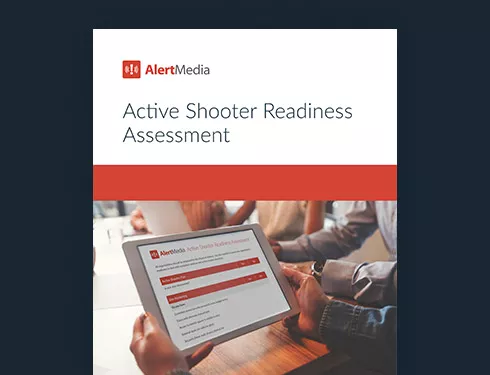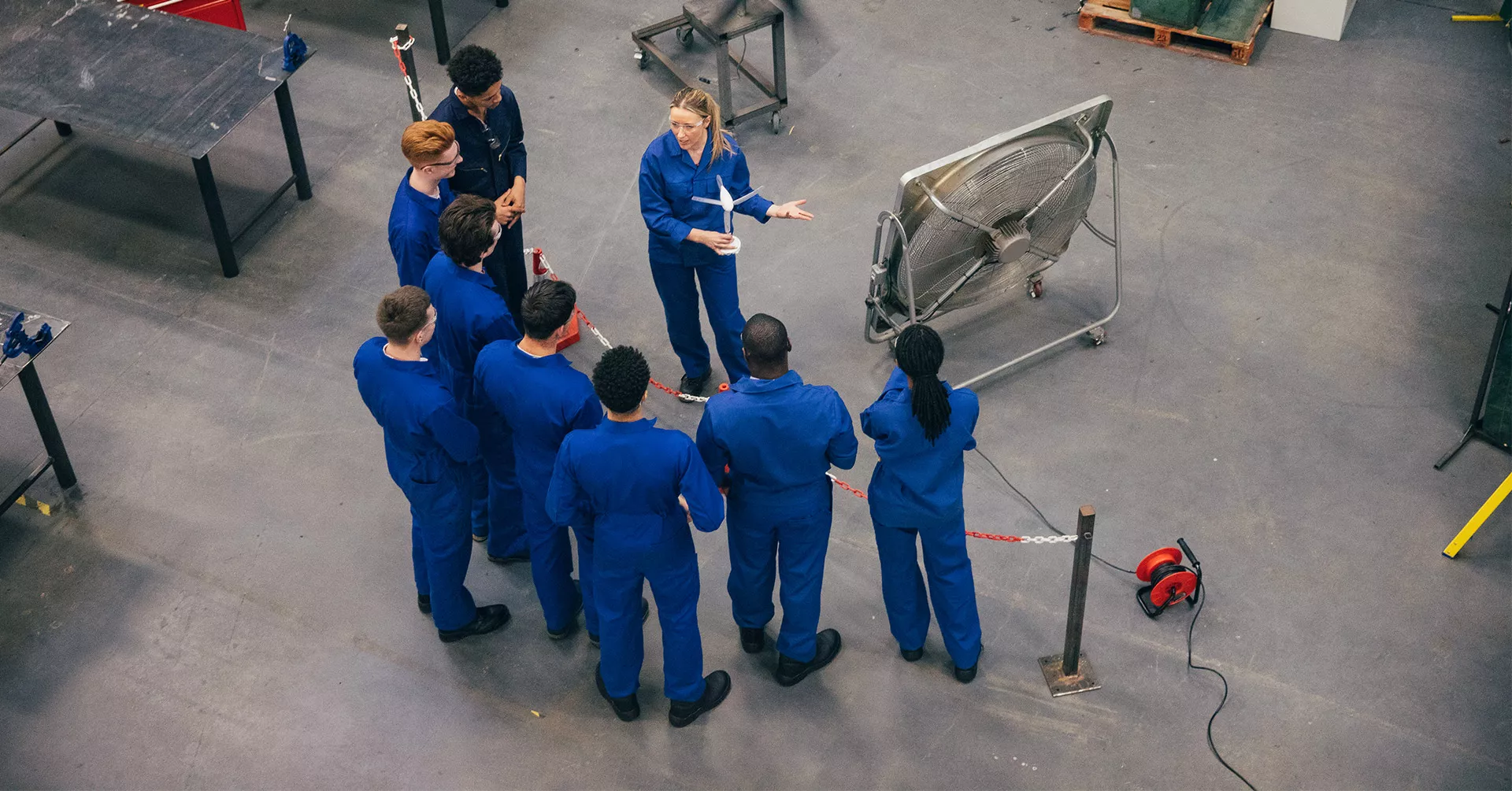
Active Shooter Planning: Prevention, Preparedness, and Response
It’s natural to want to avoid thinking about a mass shooting at your workplace, but having a documented response plan in place is vital to keeping employees safe during a crisis. In this article, we’ll cover what to include in your plans to best prepare your people and business.

Most business leaders would prefer not to think about active shooter situations occurring at their organization. It’s easier to relate these events to things you see on the news or in press conferences with local law enforcement.
But these kinds of events have seen a steep increase in occurrence in the U.S., the rate doubling from 2017–2021. Employers need a formal emergency action plan related to active shooter events to properly prepare their employees and business for the unthinkable.
In dangerous situations, mere seconds can be the difference between safety and injury, or even loss of life. If an active shooter threatens your company, employees may be unprepared to respond, wasting valuable time trying to figure out what to do. To prevent this from happening, you should develop a plan that carefully outlines what your employees (and your organization) should do during every phase of an active shooter situation.
By the end of this article, you’ll know exactly how to create an active shooter response plan, how to train your employees, and the steps you can take to prepare your business.
Active Shooter Response: Roles and Responsibilities
Before creating an active shooter plan, you’ll need to lay some groundwork with key stakeholders. It’s essential to designate people within your company to direct the effort. Your employee safety team needs to complete several vital functions, including:
- Leadership: A designated director of emergency management
- Training: Experts who can help prepare employees for emergencies, such as active shooter incidents
- Communication: Person(s) in charge of handling the mass emergency notification software and disseminating information.
- Monitoring/Reporting: A team to actively monitor reports from law enforcement, open source intelligence, and media. This team will escalate threats deemed credible and keep safety leaders informed throughout the event.
- Site Security: The team responsible for securing the workplace and addressing vulnerabilities.
If your company does not already have a full-time emergency management or business continuity role, now is the time to establish a leader or leaders. This person will be in charge of coordinating all emergency operations plans, including your active shooter response plan. Depending on the company’s size, the responsibilities listed above might fall on one person’s shoulders or be dispersed across separate roles and even departments.
How to Create an Active Shooter Prevention Plan
1. Establish prevention techniques
The most effective way to prepare for an active shooter event is by implementing measures that attempt to prevent the event completely. While there are no clear-cut indicators that a current or past employee might engage in this kind of violent crime, a robust active shooter preparedness plan should cover red flags and behaviors to look out for. Start by incorporating three key elements into your prevention plan:
- Training programs to teach employees about recognizing potential violent behavior
- Practical reporting systems to record threats
- Intervention measures to properly evaluate and combat issues
Between 2006 and February 2020, 13 mass workplace shootings were carried out by a current or former employee—roughly one per year on average. To help keep this from happening at your organization, prepare your employees help identify others who are headed down a violent trajectory. Your company should educate employees about common indicators of perpetrators and patterns of behavior that may contribute to workplace violence through pamphlets and instructional videos, such as those from the U.S. Department of Homeland Security (DHS). Training like this will equip your employees to better recognize potentially dangerous individuals.
Common pre-attack behaviors to monitor:
- History of aggression toward authority figures
- Recent acquisition of multiple firearms
- Interest in explosives
- Fascination with past shootings/mass attacks
- Traumatic life events such as a death, breakup/divorce, or loss of employment
- Being the victim of bullying in the workplace
Accessible reporting procedures
However, merely training your employees on these warning signs will be futile unless your company has set up the proper channels through which employees can safely report observations. Reporting a coworker is a daunting task that most employees would rather avoid, especially if there is no easy, anonymous way to make the report. To simplify the process, create a single, centralized reporting system. Explain to your employees how the system works, and assure them that anything reported through the channel will be kept confidential.
Lastly, take all reports seriously, and effectively address them to mitigate threats. The individuals in charge of evaluating threats should create a standardized plan on how to handle every report. Members of your company from human resources, security, employee assistance, and mental health teams should be involved in creating a plan of action to address the issue.
2. Risk assessments and site hardening
Some businesses are more prone to attacks than others based on factors such as the controversiality of business, security strength, and location. Your company can combat these weaknesses by hardening your site against the threat of violence. Start by conducting a threat assessment to pinpoint key weaknesses within your workplace, and work to fix these vulnerabilities.
The simplest way to protect your employees is by making sure your workplace is well protected from external intrusion. First, ensure that your building has controlled access and only authorized personnel can enter. By instituting security personnel, locks, and badged entry, you can ensure that no intruders gain access to your building. Your second line of defense should include doors with alternate manual locks and solid external doors (not glass) to further shield from any potential shooters and obstruct the shooter’s view. Additionally, identify interior shelter spaces that employees can use during an active shooter event.
In addition to strengthening your workplace, consider bringing in a third party to audit your physical site. Often, they will catch weaknesses that your company did not notice.
3. Create an emergency evacuation plan
During an active shooter situation, your organization’s first priority should be to get as many people as far away from the shooter as possible. Developing an emergency evacuation plan is foundational to your overall active shooter planning. It should outline how you will communicate with employees and the specific escape routes they should take, accounting for everyone at your workplace.
Implement a notification system to improve communication
During an active shooter event, communication is vital to ensure the safety of all of your employees. Without proper communication channels, companies are unable to track the status of their employees in a disaster, which creates even more chaos and confusion. However, people may not have access to their normal modes of communication, they may forget to check, and networks may fail. Being able to communicate through multiple channels—email, cell phone, text, mobile app, even pagers—will ensure your communication gets the broadest distribution possible.
Tragically, communication barriers have had real-world implications during attacks in populated areas, such as the Boston Marathon Bombings. As contestants and spectators all tried to make calls at the same time, many of those calls didn’t make it through. Many of them resorted to communicating via text message, a lower bandwidth option than phone calls. If your emergency plan relies on just one form of communication, you run the risk of critical communications not reaching your people.
Adopt a multichannel, two-way mass communication system such as AlertMedia to make this process seamless. With a modern emergency notification system, you can keep track of all your employees and relay crucial information in stressful scenarios.
An emergency communication system should meet the following criteria:
- Intuitive interface: Your system should allow you to send out alerts with ease with little-to-no technical training.
- Mobile support: Look for providers that offer a full-featured mobile app to ensure your team can initiate an emergency response anytime from any device.
- Two-way messaging: Ensure your system allows users to reply with status updates in addition to receiving information shared by your emergency management team.
- Wellness checks: Ask providers how they support employee surveys and wellness checks through their system—specifically, the ability to rapidly identify which employees are safe and which need additional assistance during an emergency.
- Communication templates: Speed is critical during an emergency. Look for systems that support pre-made templates for different emergency scenarios, which can help accelerate response times.
- Event pages: Your system should enable you to quickly create event pages to provide one source for all information, allowing employees to check back for updates as the situation develops.
- Integrated Threat Intelligence: Ideally, you should invest in a system that also provides integrated threat intelligence to ensure critical events can be shared as soon as possible with those in harm’s way.
If you’re looking for more help selecting an emergency notification system, our Buyer’s Guide to Emergency Communication Software can help.
In reality, it is unlikely that everyone will remain calm during a frightening attack. But the more informed your people are, the quicker everyone can get to safety and begin the recovery process.
Identify evacuation routes and shelter locations
A good evacuation plan for your business will include primary and secondary escape routes. Due to the unpredictable nature of active shooter events, companies should have strategic escape routes in place that avoid main hallways and open spaces.
Often, escape is not an option. In these cases, employees must take shelter where they are. By identifying shelter-in-place locations within the workplace, employees will have strong, secure spaces in which they can hide until the event passes. Whether this space is a conference room employees can barricade with heavy furniture or a janitorial closet with a lock, identifying these locations in advance of any acts of violence can save lives.
4. Plan for everyone in the workplace
Your active shooter planning needs to account for everyone who might be impacted by an active shooter event, including contractors, temporary workers, and guests. Customers and clients are likely to look to employees and managers for guidance and safety advice, giving all the more reason to have a robust plan in place. Given how volatile active shooter events are, you should also plan for how you will cascade critical information to those in harm’s way, such as the physical description of shooters or instructions of any police officers on the scene.
While remote workers might not be directly affected by an active shooter, they need to know what is happening with the business and their co-workers. Plan for how to communicate with off-site employees during and after the active shooter event.
Also, plan for populations with access and functional needs, as well as individuals with disabilities who may need assistance to evacuate safely. Even if your company doesn’t have any employees with lifelong access and functional needs, it’s crucial to plan for anyone who is temporarily on crutches or in a wheelchair. For these employees, getting to one of the places of shelter will often be a better course of action than trying to leave the building.
5. Active shooter training and exercises
Research into previous active shooter events has shown that 60% of active shooter incidents have already ended prior to the arrival of law enforcement officers. Due to this reality, preparing your employees for crisis situations can help save lives. Conduct training for employees at least twice a year to stay updated on the latest practices and strategies. In addition, incorporate active shooter response training into every new employee’s onboarding.
Size and scope
There are many different types of active shooter drills that can prepare your employees for these scenarios, such as lockdown and tactical drills. Company size, employee type, and business location are all factors to consider when choosing a specific type of active shooter drill. Despite the controversy surrounding active shooter drills, most experts agree that training your employees in some form or fashion is essential to protecting their safety. Often, the simplest way is the most effective way. Many companies provide their employees with comprehensive training through informational videos and pamphlets rather than performing active shooter drills. Another alternative to simulated drills is an active shooter tabletop exercise, which gives employees and safety leaders an opportunity to practice procedures and judgment calls for expected and unexpected active shooter scenarios.
First aid training
Along with active shooter training, companies should ensure that at least a portion of their employees are first aid certified and capable of assisting injured people if needed until first responders arrive. When the unthinkable occurs, employees can help save lives if they have proper first aid training and knowledge. Many companies offer first aid training services to other businesses, and it can be as simple as bringing in instructors one afternoon to teach and certify some of your employees. By training your employees, you empower them to help in disaster scenarios. You can further increase your employees’ odds of survival by equipping your workplace with first aid kits to administer emergency medical care until paramedics arrive.
Run, Hide, Fight
The most commonly recommended strategy during an active shooter event is Run, Hide, or Fight. Intuitively, our first instinct is to run away from the face of danger, and this is normally the best option during an active shooter event. Using predefined escape routes and strategies, employees should get as far away as possible. When exiting the scene of an active shooter event, they should keep their hands above their heads, and if they encounter law enforcement or other first responders, they should give descriptions and directions toward the shooter.
If running is not possible, the next best option is to find a hiding place in a secure location. Designated shelter locations should be the first place to go, but employees should find the nearest concealed spot and hide out if they are too far away. Locking doors, barricading entrances with heavy items, and keeping quiet are all crucial components of this approach. If all else fails and the shooter poses an imminent danger to an individual or group, employees should take action and attempt to incapacitate the assailant. While this is a last resort scenario, employees should know to use common office equipment or any other type of weapon that can help them gain time to escape to safety.
6. Communication
Communication during emergencies is vital to keeping everyone notified and up to date on all available information. Don’t wait until there’s an actual event to use your communication system for the first time. Ensure that it operates as expected, teams know how to complete essential tasks, and you’re taking advantage of all automation and template capabilities to save time in the midst of a real emergency.
The person(s) in charge of the emergency communication system should train on the systems they have in place. By preparing beforehand, you can have an idea of how long it takes to send alerts and what capabilities are necessary in case of an emergency scenario. Create pre-populated templates to ensure that messages can be sent out as quickly and efficiently as possible. Additionally, you should make sure you have up-to-date contact information, and test that all your employees are actually receiving notifications on the available channels.
In the heat of the moment, it’s important to quickly identify who is in harm’s way and who is safe. This serves two purposes: First, it makes sure that those who need them receive potentially life-saving alerts. Secondly, it avoids alarming any employees who are not on the scene and not in danger. Modern emergency communication systems are able to leverage location-based alerts to make this process as easy and fast as possible, but it is important to organize your system’s group and location settings, as well ensure proper alert delivery.
If your company relies on a hardwired alarm system, you should rehearse actually setting off the alarm and planning how to do so if the route is blocked. Conduct routine checks to ensure that batteries are still working and everyone in the workplace can hear the alarm.
Active Shooter Response: Best Practices
Active shooter situations are inherently chaotic, frightening, and unpredictable. While there is no one-size-fits-all approach to shooter preparedness, there are widely recognized best practices that all employees and managers should keep in mind to maximize the chance of survival and minimize the damage caused.
First, it is key to be aware of your environment. Virtually every strategy you might employ to survive or prevent an active shooter event requires you to know entry and exit points, hiding places, first aid kits, and other facts about the physical setting. Critically thinking about this can also help you identify possible dangers or weaknesses in your organization’s security or evacuation plans and help others in times of crisis.
Secondly, you must cooperate with first responders and police. Workplace violence involving firearms usually requires police intervention. When help arrives, it is important to assist in providing information but to be careful not to hinder their response. Communicating the number of shooters, their description, their location, and the locations of victims can be invaluable in saving as many lives as possible. However, in doing so, make sure to stay physically out of the way of the police so they can do their job, and keep your hands above your head to avoid misidentification of you as the shooter.
First responders at any crime scene—especially one involving armed assailants—are trained to be on high alert. For that reason, public safety experts recommend those on the scene keep the following in mind when interacting with emergency responders, such as the local police department, emergency medical services (EMS), and the fire department:
- Remain calm and follow instructions
- Put down any items in your hands (i.e., bags, articles of clothing)
- Raise your hands, spread your fingers, and keep your hands visible at all times
- Avoid quick movements and grabbing onto officers
- Avoid pointing, yelling, and distracting movements
- Exit the scene as quickly as possible—do not stop to ask questions
Finally, a quality mass notification system and plan can ensure that information is distributed accurately and promptly, which is not something to take for granted in the chaos of a shooting. Modern emergency communication systems are even able to proactively notify your team of threats such as active shooters and help you determine who is at risk. An intuitive, properly configured system can save precious time during emergencies.
Post-Event Response
Following an active shooter event, employees will feel grief, confusion, and loss. As a company, you are responsible for taking care of all your employees, specifically those most deeply impacted by the event. Recovering after a disaster takes time and patience. Be sure to provide employees with all the resources, time, and support they need. Whether that be financial assistance for medical bills or counseling for trauma, show your employees that you are there for them.
In addition, an business continuity plan should be in place to address damage recovery, reopening of business, and relief funding. With this plan in place, you will have a set procedure to handle the aftermath of disaster scenarios, simplifying the process.
During this recovery phase, misinformation will also run rampant while everyone attempts to make sense of what occurred. To prevent rumors and speculation from taking over your business, communicate proactively to ensure that everyone is on the same page. Certain emergency notification system vendors include a feature for companies to organize all activities, updates, and additional resources into a consolidated event page. This page can be used to post current details, status updates, and steps to take in the recovery process.
Active Shooter Planning Saves Lives
Active shooter events are, thankfully, one of the rarest emergencies a business may face. However, they are on the rise in the United States and can wreak long-lasting havoc on a business and its employees. While you hope to never have to use them, running emergency drills, prioritizing active shooter preparation, and practicing your organization’s response strategies can save lives.




